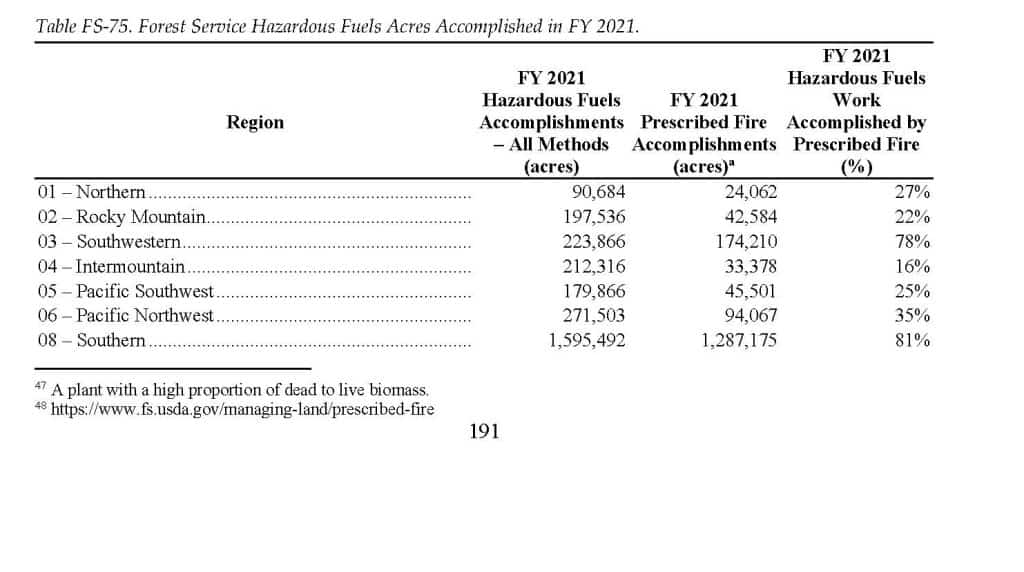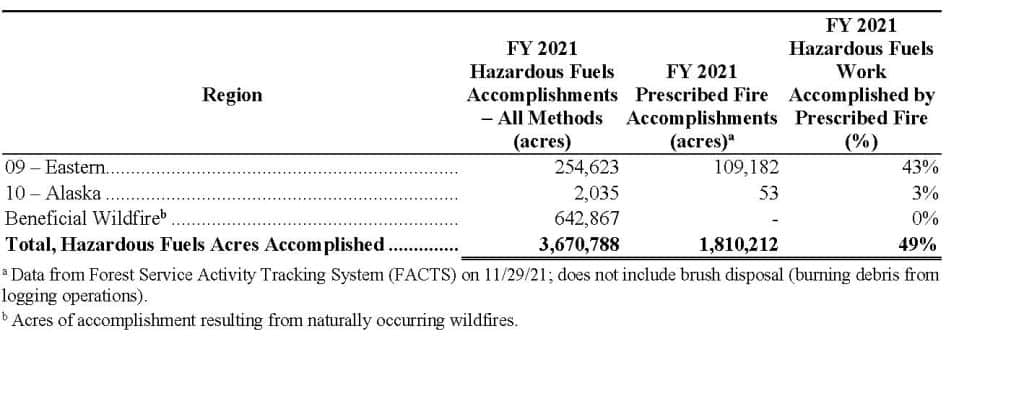

From the 2023 Budget Justification Statement
I’m sure there are plenty of interesting things in the Forest Service 2023 Budget Justification Statement. You all are welcome to point them out in the comments. Marc Heller of E&E News wrote a story on the prescribed fire and hazardous fuel numbers that I excerpted above. To simplify another way, Beneficial wildfire (BW) acres were equivalent to 36% of the PB. If the sum of BW and PB were lumped together though (fire-based hazardous fuel treatments), they would be 67% of the total acres accomplished. It would be interesting IMHO to see BW broken out by Region.
“The success of the program was primarily a result of favorable weather creating more opportunities for burning and a concerted effort to improve coordination among regions to mobilize resources to support seasonal burning,” the Forest Service said in its budget justifications to Congress as part of the spending request for the fiscal year starting Oct. 1.
“The Forest Service achieved this level of accomplishment while also managing a significant wildfire response workload, providing support to the national COVID-19 response, and overcoming challenges for performing work in a COVID-19 environment,” the agency said.
In fiscal 2021, the vast majority of prescribed fires occurred in the Forest Service’s Southern region, where the agency reported more than 1.2 million acres burned, or 81 percent of the hazardous fuels work there.
In the Pacific Southwest, which includes California, the Forest Service used prescribed fire on 45,501 acres, or 25 percent of the total hazardous fuels work.
The percentage was lowest in the Intermountain region, which covers parts of six states in the northern and middle Rockies, Great Basin and Colorado Plateau. There, prescribed fire accounted for 16 percent of hazardous fuels treatment, or 33,378 acres.
The total of 1.8 million acres across the forest system beat the 10-year average of 1.4 million acres of prescribed burns, the agency said, an indication of officials’ increased embrace of the practice, as well as conditions favoring it. Congress asked for the report in an appropriations measure.
In the South, the Forest Service said, a lack of snow as well as intermittent drying between rains makes favorable conditions for prescribed fire. Forests there grow fast and need treatment every few years, the agency said.
But in Alaska, wet conditions and snowfall make prescribed burning less needed, the Forest Service said. That may change in the future, the agency added, because spruce beetles have been killing trees in the Chugach National Forest, possibly raising wildfire threats.
For the forthcoming fiscal year, the Forest Service didn’t state an acreage goal for prescribed burns but said it plans to use various treatments on 3.8 million acres, which would include thinning and planned fire. The national forest system totals 193 million acres, and the agency has acknowledged that far more land needs hazardous fuels removal than can be done in the short term.
There’s also a discussion of the prescribed fire “controversy” which I’ll take up in another post. Again, there’s plenty of interesting facts and examples in the Budget Request so please highlight any of interest below.
It is my experience that prescribed fire acres in the Pac SW often include a significant proportion of pile burning, with some districts and forest having very little under burning acres included in their totals. While pile burning is a necessary and important step, the treatment that created the piles is also counted as a treatment. This results in counting the same acre twice within a few years, once when it is thinned and once when the piles are burned. It is super important to maintain the acres already treated. I would like to see tracking of maintenance burn acres. I also think it would be good to have targets for maintenance burning on each forest and district. Let’s not let things slip away.
The table says BD is not included from timber sales. But what if a timber sale is also a fuel reduction project? Hopefully this is clearer to others.
I agree that all these figures could be more clear. Perhaps responding to the Infrastructure Bill will lead to the FS changing the way it tracks these activities?
Pile burning is not necessarily BD. BD is typically done for timber sales that harvest commercial size wood. Pile burning is often done in areas that have not had a commercial timber harvest – the purpose of the treatment is fuel reduction but not for the reduction of fuels generated by a commercial harvest.
I’ve worked on projects that had specialized slash treatments, including hand-piling, and even firewood stacking, in special areas. On some Ranger Districts I have worked on, the timber folks often worked in fire, when staffing is needed, or during a lightning bust. Other RDs, not so much.
Thanks, A. I hope you see my point though… if a stand is thinned noncommercially and fuels are treated, or commercially, it seems like fuel wise, people should be able to take credit for fuel reduction and burning piles either way, and those should be added together for some kind of fuel reduction target-counting. Does this make sense?
“Naturally occurring wildfires” should not always be considered to be “beneficial”. There is a very fine line between “beneficial” and catastrophic. This idea is also not based in actual science, either. It seems more like dubious propaganda, in favor of letting more fires burn “for resource benefits”.
“For the forthcoming fiscal year, the Forest Service didn’t state an acreage goal for prescribed burns but said it plans to use various treatments on 3.8 million acres, which would include thinning and planned fire.” Given that the FS found the proportion of prescribed burning worthy of tracking, and more importantly, given the widespread agreement that burning is much a more effective treatment, why would the FS not want separate it from cutting down trees and try to do more of it? (I have my suspicions, including A’s point that they get to count thinning acres twice.)
Controlled burns and prescribed fire acres cannot be guaranteed with fire seasons being year-round. Of course, everything is site specific and there are still the realities of liability, when the Forest Service lights the fires. I will also never be in favor of using uncontrolled wildfires as ‘accomplishments’.
I still think they could have a goal even though achievements vary by weather etc. That is the real world of PB- we have more control over mechanical treatments than conditions for safe and effective PB.
True, there is more control over mechanical than Rx fire, but the data I have seen show there are a significant number of days within prescription that are not used in many areas. I think this is largely due to a lack of staff available during the winter and shoulder seasons, which is a budget and a policy issue. Seasonal staff are off and permanent staff are spending well-deserved time with friends and family in the fall and winter or are in SoCal where the fire season never ends some years, then they are hiring and training in the spring. When they do get a chance to burn in the off season, they have to start with the piles.
Maybe it would be better to make the target a rolling 5-year average for maintenance acres? Yes, some years have a lot more days available to burn than others. There should be an adequate number of dedicated staff for winter prep and burning. If these staff are not burning, they are prepping; if they are not prepping, they are burning. Even in years with fewer burn days, the prepping could go a long way to having areas set up for nighttime back burning during wildfire events. It wouldn’t be wasted work. They could also do more tree well burning and burning between snow patches in the spring, a practice that is rarely done these days. Having a wide range of forest types, aspects, and elevations prepped seems like a useful strategy to having a wide array of opportunities available.
I like these ideas. If there is money to spend (and there is), then these are good things to spend it on. It might also be a good idea to hand off timber sale-generated pile burning to the (permanent-seasonal) timber folks, who could be available during burning windows.
Taxpayers are going to want a lot of bang for their billions.